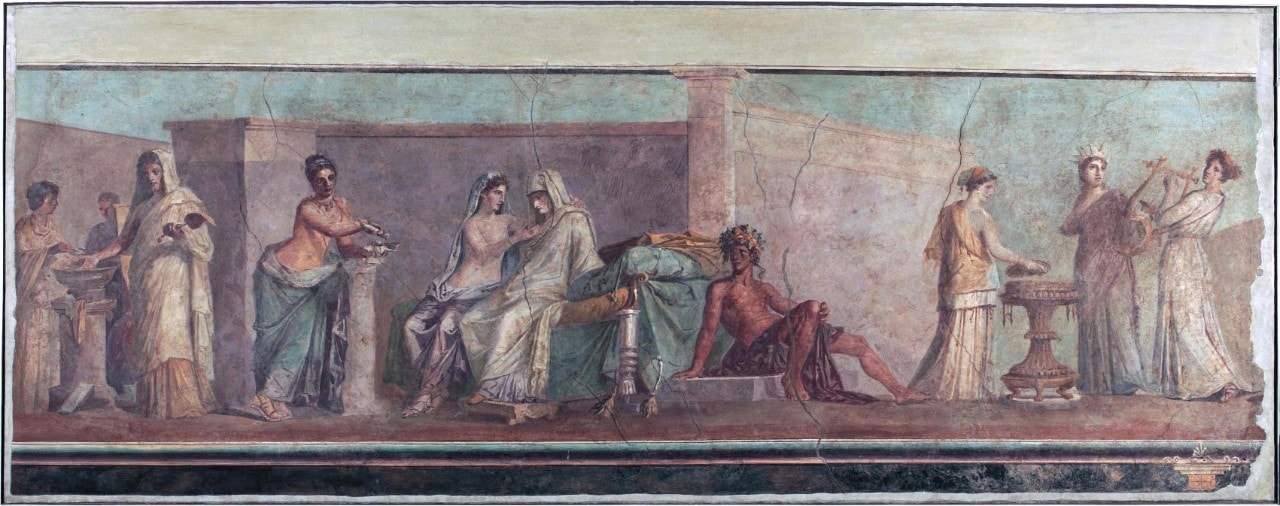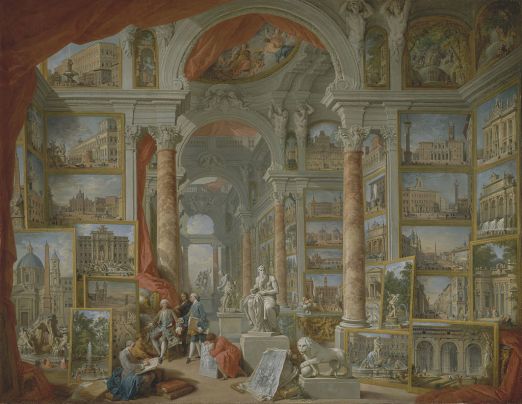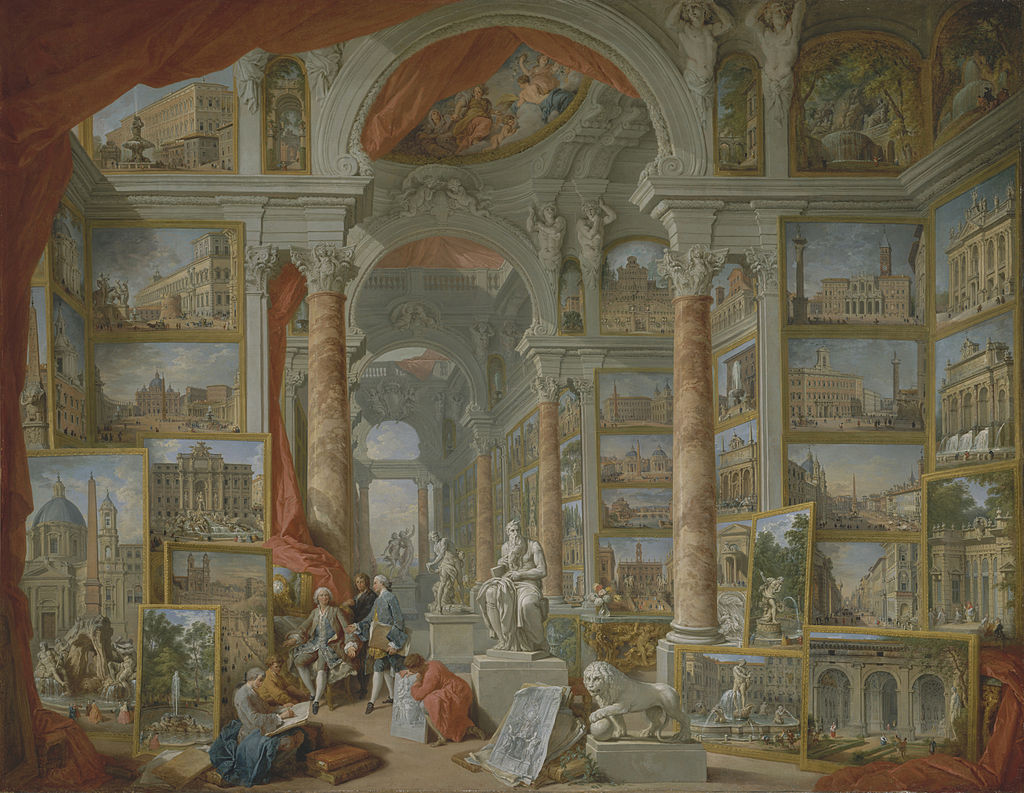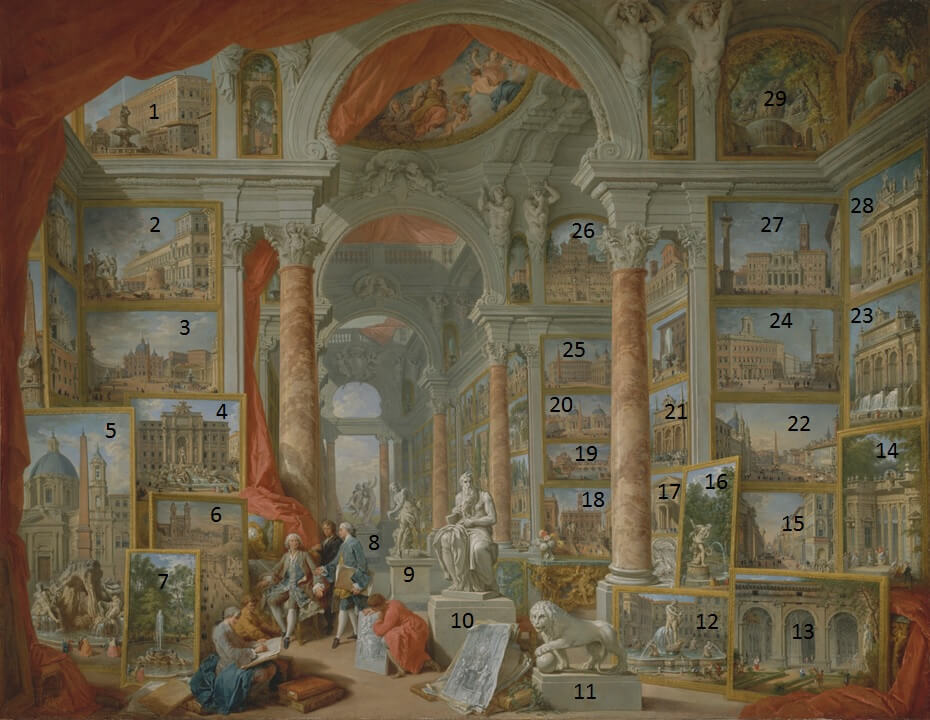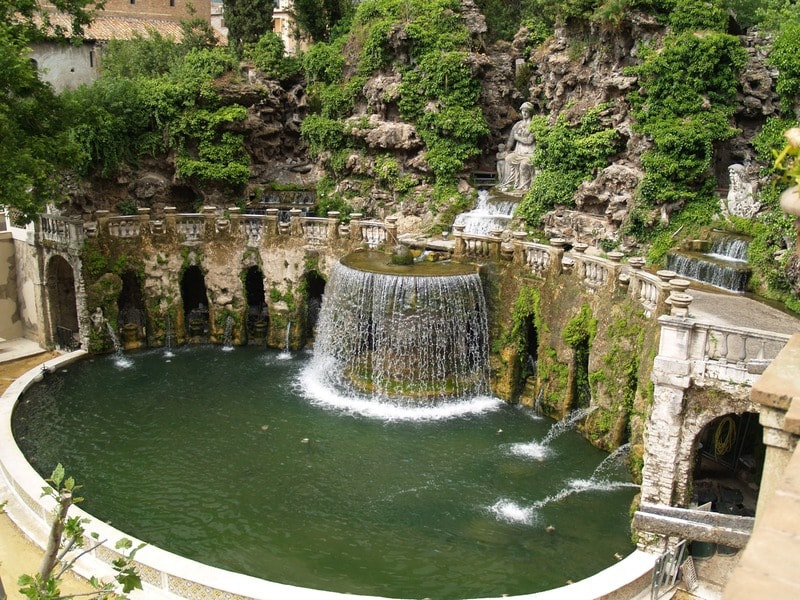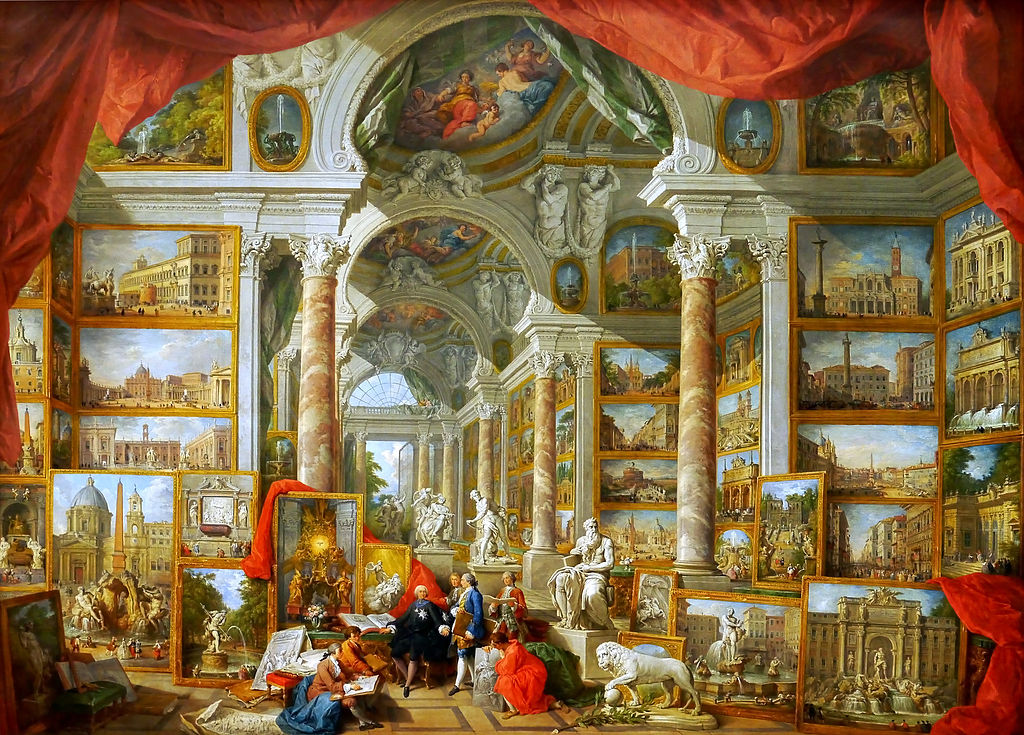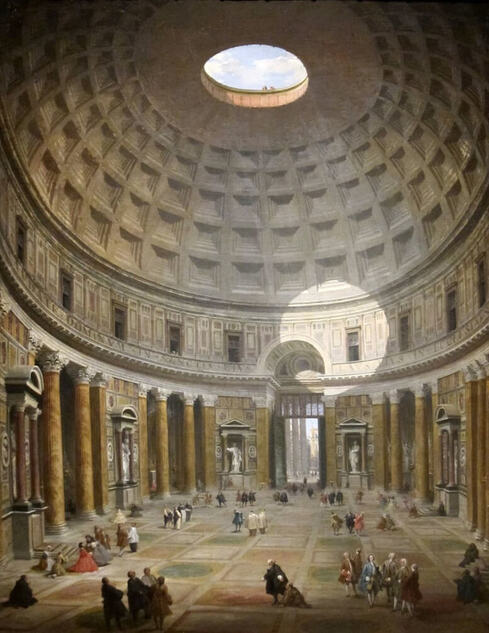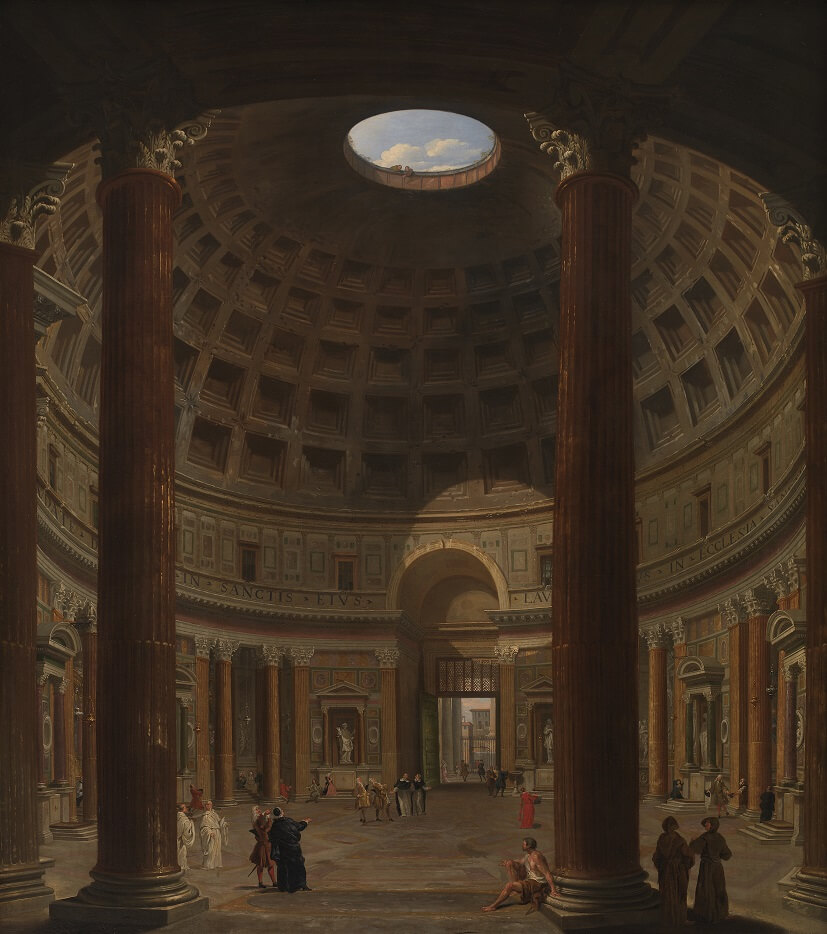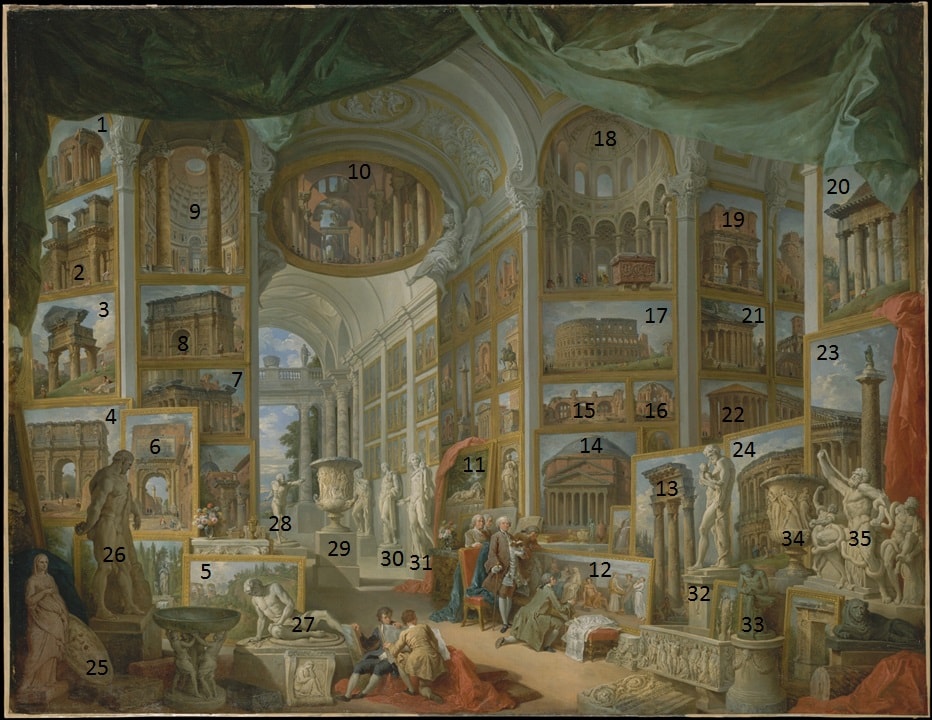 Annotated Ancient Rome Annotated Ancient Rome
Where? Room 629 of the Metropolitan Museum of Art
When? 1757 Commissioned by? Count de Stainville What do you see? On top is a green curtain that is pulled aside to show many paintings and sculptures of ancient Roman monuments. Panini and his patron Count de Stainville appear in the painting. Panini is standing directly behind the chair in the middle, while Count de Stainville is standing in front of him with a book in his hand. In the figure below the paintings are numbered to make it easy to understand what they represent.
Backstory: The painting was created together with a painting of Modern Rome, which is in the same room of the Metropolitan Museum of Art. The idea was that the monuments in this painting represent all the works that a young gentleman of a good family should see on his tour of Rome. This kind of tours was popular among the rich to educate young men about the cultural world.
There are three versions of the Ancient Rome painting and they all look slightly different. Besides the version in the Metropolitan Museum of Art, the Staatsgalerie in Stuttgart has on version, and the Louvre has another version. Why Rome? Rome was the capital of the Roman Empire. It is considered to be the birthplace of the Western civilization. It contains a large number of ruins, monuments, buildings, museums, etc., of significant historical importance. Since the beginning of the Renaissance, it has attracted many well-known artists and contributed to their development. Who is Panini? Giovanni Paolo Panini (1691-1765) was an architect, painter, and professor. He is known as a vedutisti, which is a painter of a veduta (Italian for ‘view’). A veduta is a highly detailed painting of a certain view, such as a city or landscape. While born in Piacenza, he spent most of his life in Rome, which has been the dominant theme in his paintings. Fun fact: Panini painted multiple versions of this painting within three years. The painting is part of a set of three other paintings, a painting of Modern Rome, a painting of Saint Peter’s Square, and a painting of the interior of Saint Peter’s. Because of the popularity of these paintings, he created this set of four paintings twice (remember that there were no photographs possible in his time, so this was probably the best you could get as a picture of Rome). He also created a third and fourth version of Ancient Rome and Modern Rome. Interested in a copy for yourself? Poster or canvas.
0 Comments
Where? Room 629 of the Metropolitan Museum of Art and Gallery 246 of the Museum of Fine Arts
When? 1757 Commissioned by? Count de Stainville What do you see? A large number of paintings of buildings, fountains, and monuments in Rome around 1757. The commissioner of this painting, Count de Stainville, who was the French ambassador to the Vatican in Rome between 1753 and 1757, is sitting in an armchair in the foreground. In the painting below the paintings and sculptures are numbered to make it easy to understand what they represent.
Backstory: Panini created a total of three versions of this painting. He created two similar versions for Count the Stainville. The original version is at the Museum of Fine Arts in Boston, and a copy of that version is at the Metropolitan Museum of Art. Two years later, he created a somewhat different version of this painting for Claude-François de Montboissier de Canillac de Beaufort. This version is now in the Louvre in Paris.
The Modern Rome painting in the Metropolitan Museum of Art hangs next to another work of Panini, Ancient Rome, which shows monuments and art from ancient Rome.
What is a veduta? Panini is known for painting views of Rome. These views are called veduta (plural vedute), which is a type of painting that accurately provides a view of a city or another vista. This style initiated in Belgium and The Netherlands in the 17th century and became more popular in 18th-century Italy.
There are two main types of vedute. First, the vedute prese da i luoghi, which are exact representations of a city view or other vista. Second, vedute ideate, which are scenes that also contain some imaginary elements such as buildings or monuments from the past. The current painting by Panini is a good example of the first type of veduta, while his Ancient Rome is a good example of the latter type. As photography did not exist yet, vedute were a great way for rich travelers to bring home their memories. The magnificent vedute by Panini were in high demand in the 18th century, and it is not surprising that painters sometimes created multiple versions of the same veduta painting. Who is Panini? Giovanni Paolo Panini was born in 1691 in Piacenza, Italy, and died in Rome in 1765. He was both an architect and painter and was considered to be the most influential painter in Rome during the 18th century. Early in his career, he mainly painted frescos for the rich people in Rome. From around 1729, he started to focus on painting various views of Rome for which he is best known today. Another example of a veduta painting by Panini is the Interior of the Pantheon of which one version is in the National Gallery of Art, and another version is in the Cleveland Museum of Art. Panini also painted some religious works, but these works have never reached the same amount of fame as his vedute.
Fun fact: At the end of the 16th century, rich people in Europe send their kids on tour through Europe as part of their education. These trips are referred to as Grand Tours. On these trips, kids of about 21 years old typically visited cities such as Paris, Florence, Rome, and Venice. A knowledgeable family member or a professional tutor accompanied them on their tour. For example, the great economist and one of the founders of capitalism, Adam Smith, worked for quite some years as a tutor.
Before the existence of photography, these tours were popular among the rich people in England, Germany, Scandinavia, and the United States. Veduta paintings, such as the ones by Panini, became popular among these people to preserve their memories.
Where? Gallery 217 of the Cleveland Museum of Art
When? 1747 Commissioned by? Possibly by William Drake after he completed a tour through Italy in 1745. What do you see? Around 60 people are inside the Pantheon. They are engaged in different activities like admiring the architecture, talking, and praying. The group in the right foreground may contain the commissioner of the painting, but this is not certain. The visitors look small compared to the size of the building. Most people stand or kneel in the open space in the middle. Enormous Corinthian columns and statues surround this space. In the middle background is the entrance to the Pantheon and we can identify the Egyptian obelisk in the Piazza della Rotonda in front of the Pantheon. The dome is decorated with sunken square panels (called a coffered ceiling). The light enters through the opening in the dome. You can see the sunlight just to the right of the entrance to the Pantheon. The floor is decorated with squares and circles which are also used to decorate the walls. Backstory: The view in this painting is not entirely realistic. While Panini accurately painted the Pantheon, the painting shows more than is possible from a single place in the Pantheon. Since 609 AD, the Pantheon is a Christian church and quite some modifications to the Pantheon have been made over time. As a result, the view that Panini painted is not the same as what you see today when visiting the Pantheon. For example, the bottom of the dome contains some inscriptions.
Different versions of this painting: Panini created several other versions of this painting. At least eight versions are known of which four are on public display and the others are in private collections. All versions are somewhat different from each other. The versions on public display can be divided into two types.
History of the Pantheon? The Pantheon was built between 113 and 126 AD, during the reign of the Roman Emperor Hadrian. It was built on the spot of a burnt-down Roman temple built by Agrippa between 29 and 19 BC. Pantheon literally means ‘all gods’ and was dedicated to every Roman God. However, in 609 AD the Pantheon became a Catholic church. The Pantheon is also called Church of St. Mary and the Martyrs and every week at least two masses are held inside.
The height of the dome and the diameter of the dome are the same, 142 feet (43 meters). The diameter of the opening on the top is 27 feet (8 meters). Quite some famous people, including kings and artists, are buried in the Pantheon, including Raphael. Who is Panini? Giovanni Paolo Panini was born in 1691 in Piacenza, Italy, and died in Rome in 1765. He was a painter and architect, but also produced fireworks. He was the best-known painter of veduta, which are detailed and factually correct paintings of city views or buildings. He was popular among tourists for his paintings with views of Rome and some of the most impressive buildings in Rome. As photography did not exist yet in the 17th century, tourists asked Panini to draw some of the major sights as a memory to their trip. Two of his most famous paintings are Ancient Rome (with versions in the Louvre, Metropolitan Museum of Art, and the Staatsgalerie in Stuttgart) and Modern Rome (with versions in the Louvre, Metropolitan Museum of Art, and the Museum of Fine Arts).
Fun fact: The opening on top of the dome is called the oculus. This was a common design feature in Roman and Byzantine art. Most importantly, it allows light to enter the building. In addition, it allows rain to enter, which helped to cool down the interior of the building during the Summer months.
In the current version of this painting, Panini painted two people on the edge of the oculus, peering into the Pantheon. This was a small joke by Panini as in reality people would not be able to get on top of the dome. Interested in a copy for yourself? Poster or canvas of the slightly different version in the National Gallery of Art.
Where? Gallery 30 of the National Gallery of Art
When? About 1734 Commissioned by? Unknown What do you see? Around 50 people are inside the Pantheon. They are engaged in different activities like admiring the architecture, talking, and praying. They look small compared to the size of the building. Most people stand or kneel in the open space in the middle. Enormous Corinthian columns and statues surround this space. In the middle background is the entrance to the Pantheon and we can identify the Egyptian obelisk in the Piazza della Rotonda in front of the Pantheon. The dome is decorated with sunken square panels (called a coffered ceiling). The light enters through the opening in the dome. You can see the sunlight just to the right of the entrance to the Pantheon. The floor is decorated with squares and circles which are also used to decorate the walls. Backstory: The view in this painting is not entirely realistic. While Panini accurately painted the Pantheon, the painting shows more than is possible from a single place in the Pantheon. Since 609 AD, the Pantheon is a Christian church and quite some modifications to the Pantheon have been made over time. As a result, the view that Panini painted is not the same as what you see today when visiting the Pantheon. For example, the bottom of the dome contains some inscriptions.
Different versions of this painting: Panini created several other versions of this painting. At least eight versions are known of which four are on public display and the others are in private collections. All versions are somewhat different from each other. The versions on public display can be divided into two types.
History of the Pantheon? The Pantheon was built between 113 and 126 AD, during the reign of the Roman Emperor Hadrian. It was built on the spot of a burnt-down Roman temple built by Agrippa between 29 and 19 BC. Pantheon literally means ‘all gods’ and was dedicated to every Roman God. However, in 609 AD the Pantheon became a Catholic church. The Pantheon is also called Church of St. Mary and the Martyrs and every week at least two masses are held inside.
The height of the dome and the diameter of the dome are the same, 142 feet (43 meters). The diameter of the opening on the top is 27 feet (8 meters). Quite some famous people, including kings and artists, are buried in the Pantheon, including Raphael. Who is Panini? Giovanni Paolo Panini was born in 1691 in Piacenza, Italy, and died in Rome in 1765. He was both a painter and an architect, which explains why he liked to paint buildings. He was popular among tourists for his paintings with views of Rome and some of the most impressive buildings in Rome. As photography did not exist yet in the 17th century, tourists asked Panini to draw some of the major sights as a memory to their trip. Two of his most famous paintings are Ancient Rome (with versions in the Louvre, Metropolitan Museum of Art, and the Staatsgalerie in Stuttgart) and Modern Rome (with versions in the Louvre, Metropolitan Museum of Art, and the Museum of Fine Arts).
Fun fact: The Pantheon has served as the inspiration for the Rotunda of the West Building of the National Gallery of Art. The rotunda is in the center of the main floor of the West Building and is the major entrance to the museum. The dome is similar, including the sunken square panels, and there is also an opening on the top to let the light in. The main difference, though, is that this opening is covered by glass such that the rain or snow cannot enter the museum.
Interested in a copy for yourself? Poster or canvas. |
Categories
All
|
- Home
- Blog
-
Museums
- Alte Pinakothek
- Art Institute of Chicago
- Baltimore Museum of Art
- Barber Institute of Fine Arts
- Bargello
- Barnes Foundation
- British Museum
- Church of Sant’Anastasia
- Cleveland Museum of Art
- Courtauld Institute of Art
- Detroit Institute of Arts
- Frans Hals Museum
- Galleria Borghese
- Gallerie dell'Accademia
- Getty Museum
- Guggenheim
- Hermitage Museum
- Kunsthistorisches Museum
- Kunstmuseum Basel
- Legion of Honor Museum
- Louvre
- Mauritshuis
- Metropolitan Museum of Art
- Musee d’Orsay
- Museum of Fine Arts in Boston
- Museum of Modern Art
- National Gallery in London
- National Gallery of Art
- National Museum in Poznań
- Norton Simon Museum
- Ny Carlsberg Glyptotek
- Palace of Versailles
- Palazzo Pitti
- Palazzo Vecchio
- Petit Palais
- Philadelphia Museum of Art
- Prado
- Pushkin Museum
- Ravenna Art Museum
- Rijksmuseum
- San Diego Museum of Art
- Santa Maria delle Grazie
- St. Peter's Basilica
- Städel Museum
- Statens Museum for Kunst
- Tate Britain
- Tate Modern
- Timken Museum of Art
- Uffizi
- Vatican Museums
- Wallace Collection
-
Artists
- Altdorfer
- Anguissola
- Berlin Painter
- Bosch
- Botticelli
- Boucher
- Bronzino
- Bruegel the Elder
- Brunelleschi
- Cabanel
- Caillebotte
- Canova
- Caravaggio
- Carpeaux
- Cezanne
- Cimabue
- David
- Degas
- Delacroix
- De Maria
- Donatello
- El Greco
- Fontana
- Fra Angelico
- Fragonard
- Gauguin
- Gentileschi
- Gericault
- Gonzalez-Torres
- Goya
- Hals
- Hogarth
- Hokusai
- Ingres
- Leonardo da Vinci
- Lippi, Filippo
- Longhi, Barbara
- Lorrain
- Makovsky
- Manet
- Massys
- Matisse
- Merian
- Michelangelo
- Mochi
- Modigliani
- Monet
- Panini
- Parmigianino
- Perugino
- Picasso
- Pisanello
- Raphael
- Rembrandt
- Renoir
- Reynolds
- Rivera
- Rodin
- Rubens
- Scultori
- Seurat
- Steen
- Tintoretto
- Titian
- Toulouse-Lautrec
- Turner
- Uccello
- Van der Weyden
- Van Dyck
- Van Eyck
- Van Gogh
- Van Hemessen
- Vasari
- Velazquez
- Vermeer
- Veronese
- Vigée Le Brun
-
Locations
- Books
- About Us


